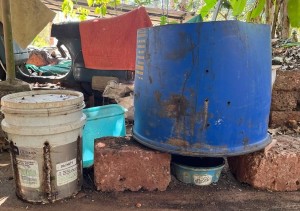John Fernandes’ success in composting kitchen waste
As garbage management is emerging as a major problem all over the State with even the Chief Minister of Goa Dr Pramod Sawant admitting that his administration has failed to find a solution to this problem as funds allotted by the government are being misused or manipulated, Ganv Bhavancho Ekvott President John Fernandes, has successfully created over 100 kgs of compost over the last two years by only using the vegetable and fruit waste generated in his house.
John shared his experience in preparing compost at home and it was published in the January edition of the Chandor Church bulletin titled Prokas, under the heading “Home Composting”.
“I find people throwing their wet waste by the roadside and in open space which is such a waste and trouble for the people when instead the same waste can be converted into rich fertilizer at home itself thus saving a lot of money,” said John.
His family of four members that include him, his wife and two children are today proud to have prepared so much of compost which can be used for the plants in their garden besides also regularly fertilizing the plants with the liquid manure obtained in the process of preparing the compost.
 According to John, he uses a large plastic container which is a cut drum in which he has drilled many holes while also keeping one hole at the bottom. “The waste needs to be aerated as the microorganisms breaking the waste need it and that is why holes have to be drilled,” he said while explaining that the hole at the bottom is to collect the liquid that gathers during the process of composting.
According to John, he uses a large plastic container which is a cut drum in which he has drilled many holes while also keeping one hole at the bottom. “The waste needs to be aerated as the microorganisms breaking the waste need it and that is why holes have to be drilled,” he said while explaining that the hole at the bottom is to collect the liquid that gathers during the process of composting.
“This collected liquid can be diluted with water and used as a fertilizer for plants,” he said adding that instead of a metal container even a clay container can be used.
This container has to be kept in a bright but shady place and protected from rain and direct sunlight. “I keep mine in a garage and place a container below the hole at the bottom to collect the water dripping from it,” he said.
 Explaining the process of preparing compost John says at the bottom of the container dry leaves have to be placed along with some garden soil or compost if available and over this the waste generated in the kitchen has to be added. Once a layer of the waste is formed, it has to be covered with dry leaves. “The layer of dry leaves should not be too thick and ensure that it is thinner than the layer of kitchen waste,” he said.
Explaining the process of preparing compost John says at the bottom of the container dry leaves have to be placed along with some garden soil or compost if available and over this the waste generated in the kitchen has to be added. Once a layer of the waste is formed, it has to be covered with dry leaves. “The layer of dry leaves should not be too thick and ensure that it is thinner than the layer of kitchen waste,” he said.
While admitting that he has only used vegetable and fruit waste and not used the fish or meat waste, he confessed that there are days when there is very little vegetable and fruit waste generated at his house.
“The gathered waste has to be turned or mixed once a week and has to be kept moist at all times,” he said while cautioning that it should not be allowed to turn dry not turn wet and soggy.
Sharing his personal experience, John suggested keeping the container covered with a lid to prevent rodents from entering it and destroying the gathered waste or the microorganism working therein. He also said it was advisable to keep some dry leaves in stock to tide over the monsoon period when they are not available.
“I do not use any cooked food or solid waste in the process and advise others also to desist from doing this,” he said. John opined that the composting occurs faster during the dry season.
Compost prepared in this manner is ready within three to four months, he said and suggested keeping another container as a standby if gets filled up before the compost is formed. Incidentally Ganv Bhavancho Ekvott has been very active in collecting the waste thrown by people on the roadside and in open spaces and this is what spurred John to prepare compost at his residence so that he leads by example!






